Alaska Fish & Wildlife News
August 2021
Adaptation isn’t Just for Wildlife
Resources to Learn about Alaska’s Outdoors
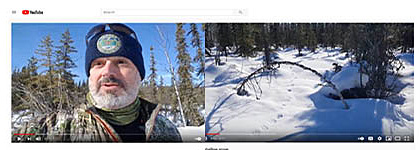
At the Alaska Department of Fish and Game (ADF&G), wildlife educators regularly teach about adaptations. We know that animals change their physiology or behavior to survive in different habitats and circumstances. The varied skillsets and backgrounds of the ADF&G Wildlife Education Program staff make it possible to adapt to the changing circumstances. We are poised to meet audiences wherever they are, which this past year largely turned out to be in their very own habitats or homes.
Enter Covid 19 in the spring of 2020. The subsequent 'stay at home' health orders across the state meant business would be far from usual for wildlife educators and the public we serve. However, we are accustomed to being flexible, to learning new skills, and adventuring into lesser-known territory to demonstrate a concept or skill. Adapting in-person programming would be the necessary to support teachers (who were also adapting to the new paradigm) and to continue providing high-quality education and information to the public.
Almost immediately after the shutdown was announced the Wildlife Education Program staff began responding to individual requests for more resources on wildlife safety and materials for language arts, outdoor skills, and other wildlife-related topics. We realized this would be a critical time for service and products to be readily available.
This major pivot could only be made possible by the support and encouragement of our program’s leadership, Kristen Romanoff. Based in Juneau, Kristen has been with ADF&G for many years. She has experienced the ups and downs of societal, weather, economic and other changes and has taught us that remaining true to the mission of ‘connecting people to the outdoors and wildlife of Alaska’ despite adversity, we can remain relevant and engaged. She has helped steer the ship that has provided opportunity and engagement for school students and adults across the state.
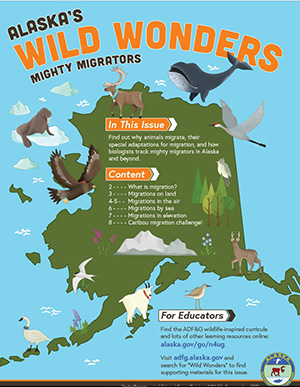
For a program that encourages Alaskans to get outdoors, it seemed a little counterintuitive to be creating new websites and activities online. Once again, we had to go where our audience was, but with a very important caveat: an invitation for students and the public to venture outdoors to experience first-hand what they were learning online. Here are just a few resources that our staff adapted to access online and encourage Alaskans to take their learning outdoors.
The new At Home or At School website was organized to help educators (teachers/parents/caregivers) find ADF&G resources in thematic units. For example: If you’re interested in learning about tracks and wildlife sign, this one-stop-shop provides ‘place-based’ standards-aligned lessons, worksheets, magazines, links, puzzles, and newly created video demonstrations.
“Gearing up skills and equipment for video production became a higher priority during the shutdown,” said wildlife education specialist Mike Taras. “It is a great way to reach more people and they can re-watch the content as needed. The trick to creating these videos is to be ready at any time, and be observant of nuances in nature to help you identify unique opportunities, like beaver tracks in the winter. The question becomes, ‘What is a beaver doing out of its lodge in the winter?’ and then you can begin to decode the observation.”

Furs, forests, bears, and scavenger hunts galore can be found on the At Home or At School page.
Alaska's Wild Wonders kid’s magazine recently printed its tenth edition and is circulated to nearly 10,000 students statewide. This magazine was included in study packets sent home by teachers as a resource not only for science but also for reading practice and comprehension. Parent and student interactions increased in the form of reading and board games. The Wild Foods issue was cleverly designed and coordinated by Jen Curl of the Fairbanks office to also be used as a game, led by a student, teacher, or parent. It helps students identify wild foods in their area and features kids outdoors hunting and gathering wild foods.
Teachers from ten different Alaska school districts joined the Wildlife Education staff online for A Tour of the Alaska Wildlife Curriculum, a professional development workshop (worth a UAA recertification credit) over a five- month period. Wildlife Education staff adapted materials and activities, making them interactive electronically, and created presentations to help students learn about ecology, tundra, wetlands, forests, research and conserving Alaska’s wildlife. One of the things teachers tell us about these professional development offerings is that they really enjoy the time to work together. So we used computer apps to help them collaborate and discuss how they would use the materials in their classrooms. Teachers were sent materials and instructions on how to conduct an inquiry lesson on adaptations to the cold and shared their results with others in the class. This mimics what their students might experience in the classroom and gives them a chance to share the results. One district even used the course to redesign their ecology units.
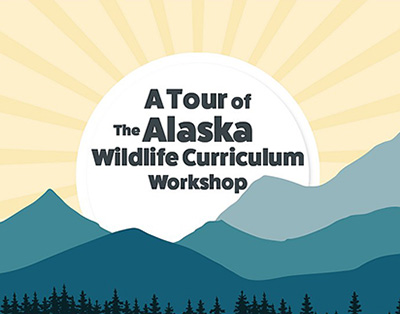
Regional Wildlife Education Specialist Heather Jameson from the Nome office trained our team in using the Google Classroom, the same platform teachers are using, to organize materials. The sessions were coupled with videos posted on the ADF&G Vimeo channel and the ADF&G YouTube channel. These resources are also available on the Canvas platform used by Alaska teachers as well as teachers outside of Alaska. As part of the course, teachers were required to go outside to gather data and perform other activities as part of their assignments.
What are teachers saying about our other materials? A Shaguluk teacher commented on the Wood Bison Teacher’s Guide, a supplemental curriculum developed by Wildlife Education staff.
“I really like that they included the decision-making processes in managing wildlife, and the activities really foster critical thinking skills. That is different than most curriculum materials we see.”
Supplementary guides including Skulls of Alaska Mammals, Bears of Alaska, and Furs of Alaska Mammals are available on our website.
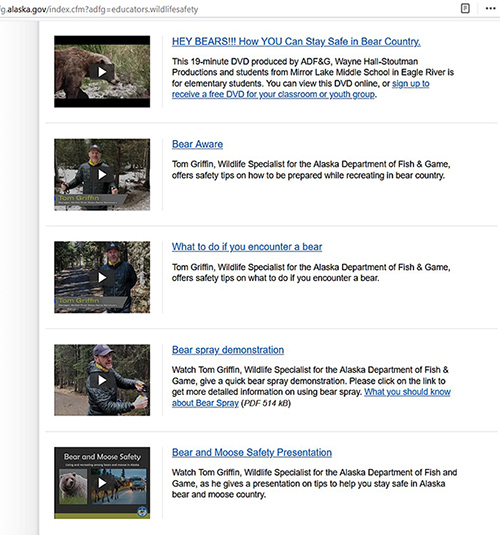
Wildlife safety information is a staple of ADF&G's outreach, especially now as more Alaskans than ever are outdoors enjoying the trail systems and other outdoor activities. In 2020 more than 8,000 students experienced wildlife safety messaging through 'Zoom' during school time, thanks to the outstanding presentations by McNeil River Sanctuary manager Tom Griffin and Wildlife Education Specialist Marian Snively in the Anchorage office. As an added bonus, it also resulted in many parents receiving the message as well. Now, all those resources are available with just a few clicks any time of the day or night on our website, Vimeo and YouTube channels.
The “Wildlife Wednesday” lecture series, normally a live event held in Anchorage and Palmer during the winter months, also went virtual, and many of the presentations are now archived for viewing. Biologists from around the state featured topics such as how biologists count caribou, winter birding, tracking in the snow, living with bears, small game hunting, and wildlife safety. Educators Sierra Doherty (Palmer), Mike Taras (Fairbanks), Heather Jameson (Nome), Abby McAlister (Juneau), and Marian Snively (Anchorage) produced monthly presentations, and attendance was at an all-time high. Wildlife education staff collaborated with biologists to share their research, show the public how they monitor wildlife health and diseases, and the other important work that helps maintain Alaska’s wildlife populations.
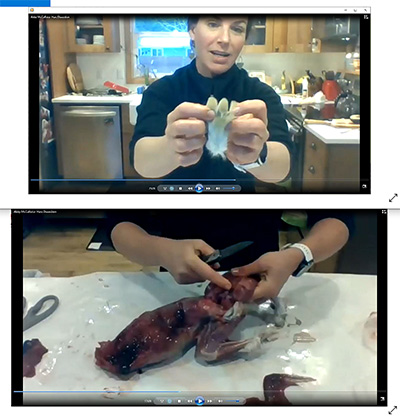
Other presentations delivered by staff include a small game field dressing demonstration delivered by journalist/educator Abby McAllister for Juneau students.
“I really thought this demonstration might be a little flat since the students were not present during the demo, so I readied my own kitchen and brought out the frozen snowshoe hare,” McAllister said. “Generally, we deal with the reaction to the smell and for the less experienced, ‘gore’ of dressing an animal. I was pleasantly surprised that the students were so engaged - more so than ever. It might have been that they were at a safe ‘distance’ from the animal, or that they were not responding to their peer’s reactions. In either case the students pelted me with questions in the chat and wanted to see what was in the stomach, which we almost never have a chance to explore.”
Alaskans are asking, "When will things be normal again?" The Wildlife Education Program probably won't ever go back completely to the old “normal,” because some new aspects actually worked better, but we look forward to engaging with our audiences face-to-face again. One thing that remains true is the outdoors is still one of the safest places to be, especially if you've adapted to it.
Brenda Duty is an Education Associate with ADF&G with a focus on teacher education for Alaska. She has been with ADF&G for 11 years and enjoys sharing the outdoors with her six children and eight grandchildren.
Subscribe to be notified about new issues
Receive a monthly notice about new issues and articles.
